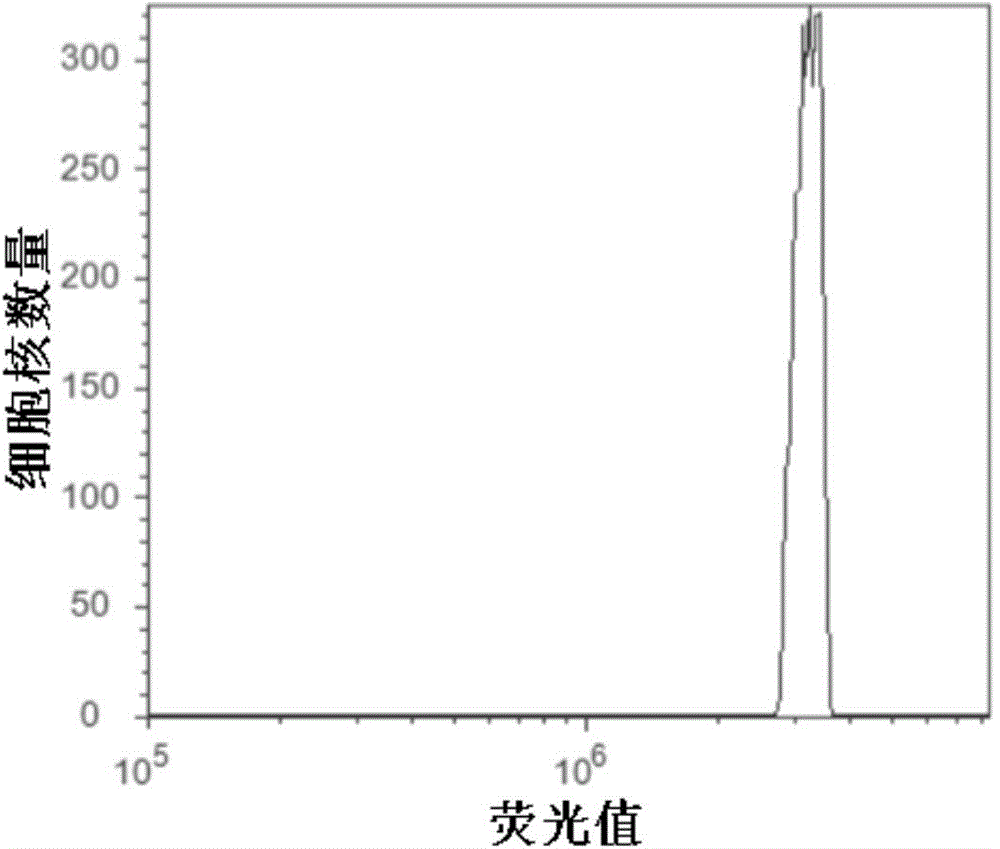Dry plant tissue treatment method applied to flow cytometry
A technology of flow cytometry and plant tissue, which is applied in individual particle analysis, particle and sedimentation analysis, preparation of test samples, etc. It can solve problems such as difficult to extract nuclei, difficult to separate, and difficult to break plant cell membranes. Achieve the effect of being easily adsorbed by dyes and improving the scope of application
- Summary
- Abstract
- Description
- Claims
- Application Information
AI Technical Summary
Problems solved by technology
Method used
Image
Examples
Embodiment 1
[0044] This embodiment is the ploidy determination of Solidago canadensis, and the components of the cell nucleus extract used in this embodiment are:
[0045] Tris: 12mMmM; Na 2 EDTA: 1mM; spermine hydrochloride: 0.2mM; KCl: 70mM, NaCl: 10mM; β-mercaptoethanol: 10mM; Triton X-100: 0.3% (vol / vol); Adjusted with NaOH solution, the cell nucleus extract is pre-stored in a -20°C refrigerator for later use;
[0046] Put 50 mg of mature leaves of Solidago canadensis (leaves dried on silica gel) into a pre-cooled plastic petri dish, then add 1 mL of pre-cooled cell nucleus extract, and then use a double-sided blade to chop the leaves. The chopping process lasts for 10 minutes. For more than 10 minutes, first filter with a 30-micron nylon membrane to collect the filtrate containing the nucleus, and then perform a secondary chopping process on the remaining leaves, that is, use a double-sided blade to continue chopping the leaves. The chopping process lasts for more than 10 minutes un...
Embodiment 2
[0050] The present embodiment is the ploidy determination of the yellow warbler, and the components of the cell nucleus extract used in the present embodiment are:
[0051] Tris: 14mM; Na 2 EDTA: 1mM; spermine hydrochloride: 0.2mM; KCl: 70mM, NaCl: 15mM; β-mercaptoethanol: 20mM; Triton X-100: 0.5% (vol / vol); Adjusted with NaOH solution, the cell nucleus extract is pre-stored in a -20°C refrigerator for later use;
[0052] Put 50 mg of the mature leaves of the oriole (dried on silica gel) into a pre-cooled plastic petri dish, then add 1 mL of pre-cooled cell nucleus extract, and then use a double-sided blade to chop the leaves. The chopping process lasts for more than 10 minutes , first filter with a 30-micron nylon membrane, collect the filtrate containing the nucleus, and then perform a secondary chopping process on the remaining leaves, that is, use a double-sided blade to continue chopping the leaves. The chopping process lasts for more than 10 minutes until all the leaves...
Embodiment 3
[0056] This embodiment is the ploidy determination of Solidago canadensis, and the components of the cell nucleus extract used in this embodiment are:
[0057] Tris: 18mM; Na 2 EDTA: 3mM; spermine hydrochloride: 0.2mM; KCl: 70mM, NaCl: 25mM; β-mercaptoethanol: 20mM; Triton X-100: 0.2% (vol / vol); Adjusted with NaOH solution, the cell nucleus extract is pre-stored in a -20°C refrigerator for later use;
[0058] Put 45 mg of mature leaves of Solidago canadensis (leaves dried on silica gel) into a pre-cooled plastic petri dish, then add 1 mL of pre-cooled cell nucleus extract, and then chop the leaves with a double-sided blade with a thickness of 0.1 mm. The chopping process lasts for more than 10 minutes. First filter with a 30-micron nylon membrane to collect the filtrate containing the nucleus, and then perform a secondary chopping process on the remaining leaves, that is, use a double-sided blade with a thickness of 0.1mm to continue chopping the leaves. The crushing process...
PUM
| Property | Measurement | Unit |
|---|---|---|
| thickness | aaaaa | aaaaa |
| concentration | aaaaa | aaaaa |
Abstract
Description
Claims
Application Information
 Login to View More
Login to View More - R&D
- Intellectual Property
- Life Sciences
- Materials
- Tech Scout
- Unparalleled Data Quality
- Higher Quality Content
- 60% Fewer Hallucinations
Browse by: Latest US Patents, China's latest patents, Technical Efficacy Thesaurus, Application Domain, Technology Topic, Popular Technical Reports.
© 2025 PatSnap. All rights reserved.Legal|Privacy policy|Modern Slavery Act Transparency Statement|Sitemap|About US| Contact US: help@patsnap.com



